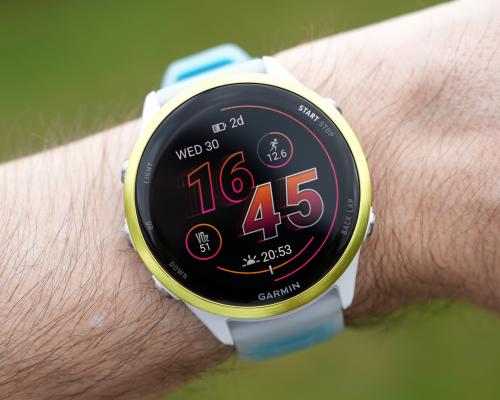
Garmin’s latest mid-range running and multisport watch has smartened up with a very bright OLED screen, voice assistant and upgraded sensors.
The Forerunner 570 continues the revamp of the company’s running watches, which have all gained more accurate GPS chips and improved heart rate monitors. The new model replaces the popular 265 and sits under the 970. It offers a similar look and feel to the top watch but with a few key features removed for a lower price.
Unfortunately the reduced price is still quite high at £450 (€550/$550/A$999), which puts the 570 well above most mid-range rivals and dangerously close to top-of-the-range money.
The 570 has quite a few updated hardware and software features, compared with the 265. It comes in a choice of 42mm or 47mm sizes and in a range of fun colours – or black for those looking for something more understated.
The polycarbonate body, metal buttons and aluminium bezel feel high quality, with a super bright, crisp and great-looking OLED touchscreen.
Like the Fenix 8 and Forerunner 970, the watch has Garmin’s new offline voice command system for quickly setting timers, accessing settings, starting activities and other functions of the watch. It will also connect to your phone’s voice assistant so you can speak to Siri or Gemini, or take calls on your wrist.
The 570 has the same revamped interface as the 970, making it a more capable smartwatch for handling notifications or controlling music on your phone. It also supports the recently released Google Maps app, but only with Android phones.
It can download various apps from the Connect IQ app store including Spotify, Amazon Music, YouTube Music or others for phone-free music on runs. Garmin Pay is available for contactless payments, though UK bank support is very limited.
The battery of the 47mm watch lasts about five days of smartwatch use with the screen on all the time, which is a day or so short of the 970 or the 265. The 570’s default screen brightness is very high, however, so turning it down one level added about a day to the battery life. It will last about 10 days with the always-on display setting turned off.
Specifications
-
Screen: 1.2in or 1.4in AMOLED
-
Case size: 42mm or 47mm
-
Case thickness: 12.9mm
-
Band size: standard 20mm or 22mm
-
Weight: 42g or 50g
-
Storage: 8GB
-
Water resistance: 50 metres (5ATM)
-
Sensors: GNSS (Multiband GPS, Glonass, Galileo, QZSS, BeiDou), compass, thermometer, heart rate, pulse Ox
-
Connectivity: Bluetooth, ANT+, wifi
Running and activity tracking
The Forerunner has Garmin’s latest optical heart rate sensor on the back and dual band GPS for some of the most accurate tracking available. It has more than 85 different sport profiles built in, so it will track most things.
For running and triathlon it packs nearly everything that the 970 offers, including wrist-based power and running dynamics, adaptive coaching plans with suggested workouts, performance condition and various VO2 Max and fitness estimations. It lacks offline maps, however, only providing breadcrumb navigation on planned routes or back to the start of your run.
It also includes Garmin’s useful recovery tools, such as training readiness, which are the best in the business. The only things it lacks are Garmin’s new impact load and running tolerance features that are limited to the 970, which is a shame.
The battery lasts about 14 hours of running with the highest accuracy settings or about eight hours while also listening to offline music from Spotify using Bluetooth headphones, which is solid but not class leading and several hours short of the 970.
The 570 has all of Garmin’s most recent general health tracking features, including its excellent body battery system, a sleep coach, morning and evening health and recovery briefings, stress, women’s health and heart health, with one exception: it lacks the ability to record an ECG. With similarly priced rivals from Apple, Google and Samsung all supporting the feature that helps spot heart conditions, it seems like a miss.
Sustainability
The watch is generally repairable with options available via support. The battery is rated to maintain at least 90% of its original capacity after two years of weekly charging. The watch does not contain any recycled materials. Garmin guarantees security updates until at least 21 May 2027 but typically supports its devices far longer. It offers recycling schemes on new purchases.
Price
The Garmin Forerunner 570 costs £459.99 (€549.99/$549.99/A$999).
For comparison, the Garmin Fenix 8 starts from £780, the Forerunner 970 costs £630, the Forerunner 165 £250, the Coros Pace 3 £219, the Suunto Run £199 and the Polar Pacer Pro £299.
Verdict
The Forerunner 570 is a great running watch that is priced just a little too high to be a wholehearted recommendation.
It looks great with standout colours, a super bright and crisp screen, and many of the good bits of the Forerunner 970. It is one of the most accurate for GPS and heart rate tracking, records almost every metric under the sun, and plugs into Garmin’s unrivalled training and recovery systems. It also works pretty well as a day-to-day smartwatch.
The lack of offline maps, a built-in torch, ECG or the latest running tolerance features, and a shorter daily-use battery life could be excused at a lower price. But at £460 or equivalent, the 570 stacks up poorly against more feature-rich rivals making it one to look out for on a deal.
Pros: super bright OLED screen, phone and offline voice control, Garmin Pay, extensive tracking and recovery analysis for running and many other sports, offline Spotify, buttons and touch, most accurate GPS.
Cons: expensive, no ECG, no offline maps, no running tolerance, no torch, limited Garmin Pay bank support, limited smartwatch features compared with Apple/Google/Samsung watches, shorter battery life than other Forerunners.







